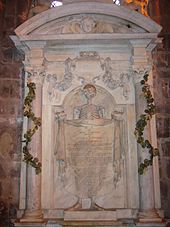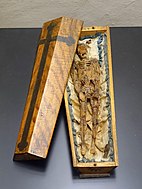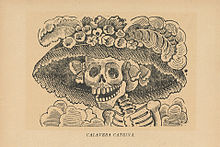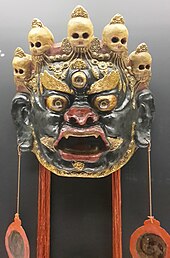
Vanitas is a genre of art which uses symbolism to show the transience of life, the futility of pleasure, and the certainty of death, and thus the vanity of ambition and all worldy desires. The paintings involved still life imagery of transitory items. The genre began in the 16th century and continued into the 17th century. Vanitas art is a type of allegorical art representing a higher ideal. It was a sub-genre of painting heavily employed by Dutch painters during the Baroque period (c.1585–1730). Spanish painters working at the end of the Spanish Golden Age also created vanitas paintings.

Et in Arcadia ego is a 1637–38 painting by Nicolas Poussin (1594–1665), the leading painter of the classical French Baroque style. It depicts a pastoral scene with idealized shepherds from classical antiquity, and a woman, possibly a shepherdess, gathered around an austere tomb that includes the Latin inscription "Et in Arcadia ego", which is translated to "Even in Arcadia, there am I" or "I too was in Arcadia". Poussin also painted another version of the subject in 1627 under the same title.

Carpe diem is a Latin aphorism, usually translated "seize the day", taken from book 1 of the Roman poet Horace's work Odes.
Symbols of death are the motifs, images and concepts associated with death throughout different cultures, religions and societies.
Satipatthana is a central practice in the Buddha's teachings, meaning "the establishment of mindfulness" or "presence of mindfulness", or alternatively "foundations of mindfulness", aiding the development of a wholesome state of mind. In Theravada Buddhism, applying mindful attention to four domains, the body, feelings, the mind, and key principles or categories of the Buddha's teaching (dhammās), is thought to aid the elimination of the five hindrances and the development of the seven aspects of wakefulness.
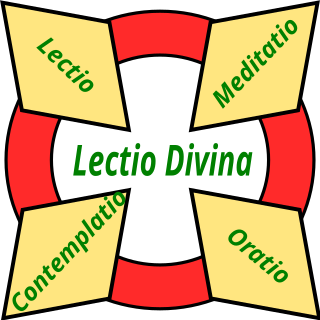
In Western Christianity, Lectio Divina is a traditional monastic practice of scriptural reading, meditation and prayer intended to promote communion with God and to increase the knowledge of God's word. In the view of one commentator, it does not treat Scripture as texts to be studied, but as the living word.
Memento mori is a common motif in art.

Jain meditation has been the central practice of spirituality in Jainism along with the Three Jewels. Jainism holds that emancipation can only be achieved through meditation or Shukla Dhyana. According to Sagarmal Jain, it aims to reach and remain in a state of "pure-self awareness or knowership." Meditation is also seen as realizing the self, taking the soul to complete freedom, beyond any craving, aversion and/or attachment. The 20th century saw the development and spread of new modernist forms of Jain Dhyana, mainly by monks and laypersons of Śvētāmbara Jainism.

Yorick is an unseen character in William Shakespeare's play Hamlet. He is the dead court jester whose skull is exhumed by the First Gravedigger in Act 5, Scene 1, of the play. The sight of Yorick's skull evokes a reminiscence by Prince Hamlet of the man, who apparently played a role during Hamlet's upbringing:
Alas, poor Yorick! I knew him, Horatio; a fellow of infinite jest, of most excellent fancy; he hath borne me on his back a thousand times; and now, how abhorred in my imagination it is! My gorge rises at it. Here hung those lips that I have kissed I know not how oft. Where be your gibes now? Your gambols? Your songs? Your flashes of merriment, that were wont to set the table on a roar?

The fundamental practice of Vajrayana and Tibetan tantra is deity yoga (devatayoga), meditation on a chosen deity or "cherished divinity", which involves the recitation of mantras, prayers and visualization of the deity, the associated mandala of the deity's Buddha field, along with consorts and attendant Buddhas and bodhisattvas. According to the Tibetan scholar Tsongkhapa, deity yoga is what separates Tantra from Sutra practice.

Alexander de Cadenet, also known as Bruiser, is a British artist working in various media: predominantly painting, photography and sculpture. He is most known for his photographic "skull portraits" and also his meteorite and Life Burger sculptures. Set within the tradition of Vanitas, these works are designed as aids to spiritual and philosophical contemplation. He has referred to his art work as "a way to give experience meaning in a tangible form; it is an exploration into the mysteries and sacredness of life and its presentation through art".

Skull symbolism is the attachment of symbolic meaning to the human skull. The most common symbolic use of the skull is as a representation of death.

Pyramid of Skulls is a c. 1901 oil on canvas painting by French Post-Impressionist artist Paul Cézanne. It depicts four human skulls stacked in a pyramidal formation, a subject matter that increasingly preoccupied Cézanne in later life.
The five faults and eight antidotes are factors of samatha meditation identified in the Tibetan Buddhist tradition. The five faults identify obstacles to meditation practice, and the eight antidotes are applied to overcome the five faults. This system originates with Maitreyanātha's Madhyānta-vibhāga and is elaborated upon in further texts, such as Kamalaśīla's Stages of Meditation (Bhāvanākrama). This formulation has been commented upon by generations of Tibetan commentators. This formulation derives originally from the Yogācāra tradition.

Maraṇasati is a Buddhist meditation practice of remembering that death can strike at any time, and that we should practice assiduously (appamada) and with urgency in every moment, even in the time it takes to draw one breath. Not being diligent every moment is called negligence by the Buddha. In the earliest discourses of the Buddha, the term 'Maranasati' is only explicitly defined twice, in the two suttas AN 6.19 and AN 6.20.

In Ictu Oculi is a very large oil on canvas painting by the Spanish Baroque artist Juan de Valdés Leal. It is dated to 1670-72, and was commissioned by the Brotherhood of Charity lay confraternity for the Hospital de la Caridad, Seville, a resting place for the old and a burial ground for paupers.

Frans van Everbroeck was a Flemish still life painter who is known for his fruit still lifes, vanitas still lifes and pronkstillevens. He was active in Antwerp, Amsterdam and London. The Dutch painters Abraham Mignon and Maria van Oosterwyck are regarded as his followers.
Illusory body is term for one of the Six Yogas of Naropa, also called luminosity. In his commentary, Pema Karpo says that the clear light is experienced briefly by all human beings at the very first moment of death, by advanced yogic practitioners in the highest states of meditation, and unceasingly by all Buddhas.

Memento Mori is the fifteenth studio album by English electronic music band Depeche Mode, released on 24 March 2023 through Columbia. The album was produced by James Ford, and marks their first album in six years since 2017's Spirit, the longest period of time between albums in the band's history.

Still Life: An Allegory of the Vanities of Human Life is an oil-on-panel painting by the Dutch Golden Age painter Harmen Steenwijck. Created around 1640, the work is an allegorical vanitas. It has been in the collection of the National Gallery in London since 1888.



